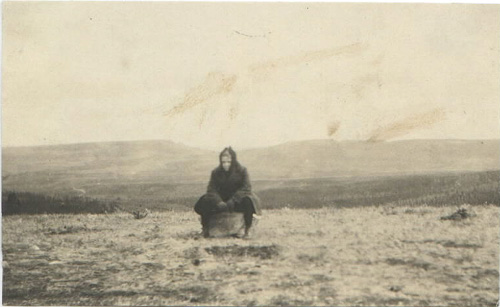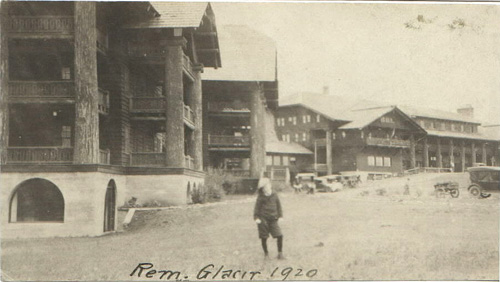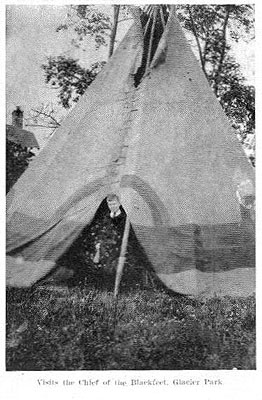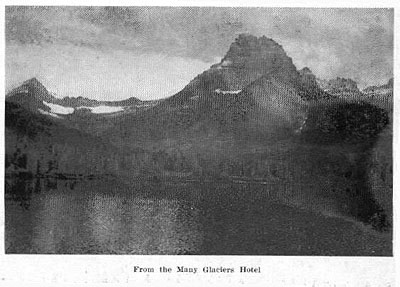CHAPTER III
I left off the last chapter when
we got to Glacier Park Hotel. The next morning we went out to see what
things looked like around there. We took some kodak pictures of the
Indian teepees and bought a parfleche to send home for the Indian room.
A parfleche is of raw moose skin and painted with ornaments and is to
carry their pemmican and medicine in when they go on the warpath.
It was raining but we decided to go to the Many Glaciers Hotel, 55
miles north, and the motor bus left at 1:30 so this just gave us. time
to go down stairs and take a swim. This is a dandy hotel made of big
logs and hung full of bear skins and big elk heads and buffalo heads
and Navajo blankets. There were about 300 people there but it is so big
it was not crowded very much. The swimming pool is white tile and the
deepest part is about seven feet. I could not touch bottom so I dived
in one end and swam clear to the other end to get out again. They
charged fifty-five cents to go in. I nearly missed my dinner. I ate
very fast but anxious to get among the mountains; I did not care if I
got anything to eat or not.
We left at 1:30 and traveled around the mountains up and down and going
down one fast my cap blew off and the driver would not stop for me to
get it so they tied a blanket around me and over my head till I looked
like an Esquimo.

It was pretty cold up in the mountains where we crossed the divide.
Divide Mountain is about 8,500 feet where we go over it. The road is
fair but they are working on it. They run big automobile busses that
hold 12 people and they run fast and all close together.
After
we crossed another mountain we went down a long road full of curves and
stopped at the Saint Marys station, where they have to transfer to go
to the Going-to-the-Sun chalets on the steamer. We got out to get a
little exercise and when I was writing a postal card I forgot my new
fountain pen that dad got me at St. Paul. Dad said I would lose my head
if it wasn't tacked on. The Blackfeet Indians camp here in the summer.
We were off again for Many Glaciers, the main stop, it was very
tiresome riding up and down the mountains seeing no one but a bus
occasionally from Many Glaciers or different lodges. We got there at
about 5:30. 55 miles from nowhere, but--oh, such beautiful scenery.
Here is Lake McDermott, Stark peak, Mount Grinnell and Wilbur and
trails leading to places such as Iceberg Lake located high in the
mountains.
Many Glaciers Hotel is built of heavy logs and the supports are trees
without the bark on. The front veranda is a kind of pier that runs out
into the Lake McDermott. Stark peak rises right up from the edge of the
lake across from the hotel. The other peaks are nearby. Right behind
the hotel are the stables where they keep the horses for trips around
in the mountains; they charge $4 apiece for the nearest trip and $20
apiece for the long trips.
They have boats and fishing tackle to go fishing on the lake. We went
out fishing but did not catch any for it was too late as it was cold.
We tried it with flies and bait. We chased a wild duck around the lake
trying to get a snapshot but soon he flew. We got some kodak pictures
and saw 16 big horn mountain sheep and some deer on the mountain side
but they were too far away to get a good picture.
They have a big log fire in the hotel and when they all come in from
their horse-back trips they gather around the fire and tell about their
trips. They charge $6 a day up to $10 a day but it is cheap for they
have to get all their eats in by hauling it over the mountains by bus
and besides they only can have it open for about three months in the
year. They could not swim in the lake because of the water from
Grinnell glacier and the snow off the surrounding mountains. They have
to keep about two hundred head of horses and they have to haul in the
feed for them too. The mountains are all around and they stick up into
the clouds and when the sun goes down it gets cold very quick and is
soon dark. When the moon gets up above Stark peak and shines down on
the lake it is the most beautiful scene in Glacier Park, and that is
going some.
We took the trip to Going-to-the-Sun Mountain which is at the upper end
of Saint Marys lake. There was a priest in our bus on the way down as
far as Lower Saint Marys Lake and we had a good visit together. I was
feeling rank because they wouldn't let me go to Iceberg Lake on
horseback alone. They have built a dam between McDermott and Saint
Marys Lake to irrigate land. We passed a drove of horses they were
bringing out for the winter. We passed a lot of Indians working on the
road and got to the steamboat landing for the 5 o'clock boat to go up
to Going-to-the-Sun Mountain. The narrows are about half way up and the
chalets are on the rocks like Gibraltar straight up from the water
about 200 feet and you have to climb up stairs to get to them. They
have an old gray horse hitched to a sled to haul up the grips and
baggage. There is not room enough to build a hotel there so they have
six or seven chalets built up on stilts or the like. If you would fall
out of the window on the lower side you would fall into the lake and
you can step out of the upstairs window onto the ground on the upper
side. The lake is very narrow here, and the mountains very high all
around. Some of them are Almost-a-dog, Goat Mountain and the highest is
Going-to-the-Sun Mountain.
It is about 10,000 feet high and the clouds cover it at the top most of
the time. Goat Mountain is noted for the goats that stay on it and we
saw some white fellows away up on a cliff.
Dad and I went up to the horse corral where they kept more than two
hundred, with about 150 saddles, right in among the trees; they keep
the best saddles in a tent and every night the horse wranglers drive
the horses up four or five miles into the mountains to get what little
grass there is along the mountain streams. They have the best cowboys
to handle them and they gave us an exhibition of lassoing. One of them
picked up a horseshoe from the ground while he was on the galloping
pony. The horses have hard use as they do not have feed except what
they rustle for in the gulches.
By the corral they have a garbage heap and the bears come down every
night about sun down. They did not come for us as there was a lot of
college boys from Culver who made a noise and would not keep quiet. Mr.
and Mrs. Van Hoast of Chicago, were in our chalet and we visited with
them till midnight. There was no heat. There was no heat except the
fireplace and the bed rooms were cold but we had lots of blankets. The
moonlight here was more beautiful than it was at Many Glaciers. If
Switzerland can beat this place it is going some I know. We had fresh
trout for breakfast. It was so late and cold that we did not go fishing
as they would not bite and they were closing the park so we did not
have time to stay any longer.
We went down the lake on the boat and climbed up the mountain at Saint
Marys station and saw the Indian camp and gathered a lot of strange
flowers and nearly got lost in the thick woods.
When we got back to Glacier Park Hotel we got a horse from an Indian
and went for a ride and visited with Clark, the Indian carver, and got
some relics from him. Dad wanted to get some buffalo skulls to send
home but they were all broken and the horns rotted away so he didn't
send any. Clark is deaf and dumb but he sure does know how to carve
things out of wood and bone; he is married to a white woman.
We went in swimming before supper and after that we spent the evening
fitting out mother with mountain outfit. All the women and girls wear
men's clothes when they travel in the mountains; they have high top
shoes and wear trousers like men and coats too and caps also. We could
not find a pair large enough for mother so we took the extra big men's
size of trousers and coat. When we got her dressed up she did look
swell. We met Mr. J. W. Shultz, the author of "Blackfeet Indian
Stories." He lived with them in the early days and was married to
Nat-ah-ki, a beautiful Indian girl, but she died some years ago and his
story of "My Life as an Indian," is one of the most interesting I ever
read. He and Dad were both of them adopted by the Indians and they had
a good time visiting about their old time with the Indians. His Indian
name is Api-ku-ni and dad's is Tchanti-tanka so he wrote in one of his
books: "Don't you wish that we could have again the buffalo days and
all the adventure and fun of that dead and gone than?" and signed his
Indian name as a souvenir of the meeting. We decided to go on west on
the daylight train so we could see the country. I will tell about that
in the next chapter. |




